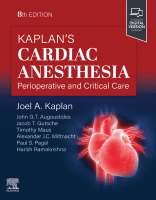Physical Address
304 North Cardinal St.
Dorchester Center, MA 02124

Key Points 1. While medical treatment and surveillance can be used to manage select aortic pathology, it is not uncommon for patients with aortic disease to present for surgical intervention. In the setting of certain acute aortic syndromes, surgery is…

Key Points 1. Comprehensive preoperative, intraoperative, and postoperative care of the adult with congenital heart disease (ACHD) requires a solid understanding of the most common congenital heart defects and the reparative and palliative procedures used to treat them. 2. The…

Key Points 1. Although various valvular lesions generate different physiologic changes, all valvular heart disease is characterized by abnormalities of ventricular loading. Changes in atrial pressure and volume are now recognized in valvular pathologies as well. 2. The left ventricle…

Key Points 1. Anesthesiologists are part of a multidisciplinary patient management team. 2. Updated guidelines identify appropriate indications for coronary artery bypass grafting (CABG) versus percutaneous coronary intervention (PCI) in patients with multivessel or left main coronary artery disease (CAD).…

Key Points 1. Monitoring the effect of heparin is done using the activated clotting time (ACT), a functional test of heparin anticoagulation. The ACT is susceptible to prolongation because of hypothermia and hemodilution and to reduction because of platelet activation.…

Key Points 1. Cardiac surgery–associated brain injury is common, multifactorial, and often preventable. 2. Electroencephalography can detect both cerebral ischemia or hypoxia and seizures and can measure hypnotic effect. 3. Middle-latency auditory-evoked potentials objectively document inadequate hypnosis. 4. Brainstem auditory-evoked…

Key Points 1. Intraoperative transesophageal echocardiography (TEE) plays a valuable role in interventional cardiac procedures, when used to guide transseptal puncture, evaluation of left atrial thrombus, closure of paravalvular leaks, transcatheter valve deployment, and during removal of transvenous lead extractions.…

Key Points 1. An ultrasound beam is a continuous or intermittent train of sound waves emitted by a transducer or wave generator. Ultrasound waves are characterized by their wavelength, frequency, and velocity. 2. Doppler frequency shift analysis can be used…

Key Points 1. Standard monitoring for cardiac surgery patients includes electrocardiography, invasive blood pressure, central venous pressure, urine output, temperature, capnometry, pulse oximetry, and intermittent blood gas analysis. 2. Additional monitoring is based on specific patient, surgical, and environmental factors.…

Key Points Antiischemic Drug Therapy 1. Ischemia during the perioperative period demands immediate attention. The impact of ischemia may be both acute (impending infarction, hemodynamic compromise) and chronic (a marker of previously unknown cardiac disease, a prognostic indicator of poor…